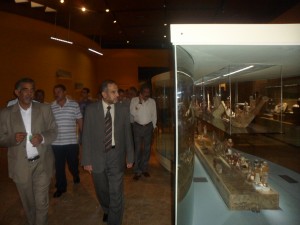 Suez is a marginalised city, even by Egyptian standards. While it is no secret that most of the nation’s funds go to our major two cities, Cairo and Alexandria, any resident of Suez will tell you that the city was, more than any other, neglected by Mubarak . In fact, it is widely known that Suez was the only city never visited by Mubarak during his 30 years of presidency.
Suez is a marginalised city, even by Egyptian standards. While it is no secret that most of the nation’s funds go to our major two cities, Cairo and Alexandria, any resident of Suez will tell you that the city was, more than any other, neglected by Mubarak . In fact, it is widely known that Suez was the only city never visited by Mubarak during his 30 years of presidency.
Perhaps the opening of the city’s newest museum might put it on the national cultural map. The Suez national museum was recently visited by the governor of Suez, Samir Aglan, where he inspected the showrooms and made sure everything was ready for its opening, scheduled for 24 October.
The museum is located on the banks of the Suez Canal and consists of the main building, a garden and a parking lot to accommodate visitors. The main building will include a hall for VIP guests, a lecture hall, cafeteria, library and storage facilities for antiquities.
The garden is approximately 6000 square metres and has rare plants including papyrus and lotus as well as a cafeteria which overlooks a pool containing a boat of Pharaonic design and is surrounded by statues from the Greco-Roman period. The garden will be illuminated by light, adding a new landmark to Suez.
“The museum is not only specific to Suez, except when it comes to showcasing the history of the Suez Canal from the ancient times to this day, as well as certain key periods in our history. The other showrooms portray Islamic, Pharaonic, and Greco-Roman histories among others and the museum is meant to attract all sorts of audiences, not just those with an interest in Suez,” a museum spokesperson said. “The museum was officially opened last January by the Minister of Antiquities but this is the first time that the museum will actually be open to the public. We hope no more delays will hinder its public opening,” he added.
The museum has an agreement with the governorate education directorate to conduct workshops for children and host lectures targeted specifically towards students. The museum’s library will include books that focus on the fields of history and antiquities, and will be open to the public.
The halls of the museum showcasing the Suez Canal will include the Sesostris hall, the navigation and trade hall, which exhibits different boats and ships throughout the eras which have had an impact on the canal, the mining hall, the Qulzum hall and Mahmal hall, which focuses on Suez’s important role in transporting the Kaaba cover from Cairo to Mecca.
The museum will bring more attention to Suez’s importance in Egyptian history and will hopefully become a major landmark. The museum may just see the negligence this ‘city of martyrs’ has suffered from for a long time finally end.




